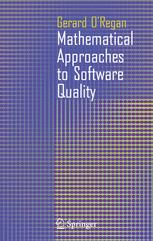

Most ebook files are in PDF format, so you can easily read them using various software such as Foxit Reader or directly on the Google Chrome browser.
Some ebook files are released by publishers in other formats such as .awz, .mobi, .epub, .fb2, etc. You may need to install specific software to read these formats on mobile/PC, such as Calibre.
Please read the tutorial at this link: https://ebookbell.com/faq
We offer FREE conversion to the popular formats you request; however, this may take some time. Therefore, right after payment, please email us, and we will try to provide the service as quickly as possible.
For some exceptional file formats or broken links (if any), please refrain from opening any disputes. Instead, email us first, and we will try to assist within a maximum of 6 hours.
EbookBell Team

4.8
74 reviewsThe now customary expectation for high-quality software products places an immense demand on industries and organizations to fulfill this need and to consistently produce quality software.
Mathematical Approaches to Software Quality provides a comprehensive introduction to various mathematical methodologies needed for developing this high-quality software. The book explains the main features of these approaches and applies these mathematical methods to solve practical problems. For instance the chapter on technology transfer presents an overview of how these technologies may be transferred to industry.
Topics and features include:
• Expansive overview of popular formal specification methods such as Z and VDM
• Introduction to Cleanroom and software reliability
• Understanding on how to predict reliability of a software product using Cleanroom
• Broad discussion of ideas of Parnas, Hare and Dijkstra on software quality
• Introduction to UML
• Technology transfer of formal methods
This book considers the potential and limitations of the various mathematical approaches and thereby aims to give a balanced view of the usability of each mathematical approach. Written with both student and professional in mind, this book assists the reader in applying mathematical methods to solve practical problems that are relevant to software engineers. It is suitable for coursework or self-study and there is helpful material on tools to support the various mathematical approaches.
A companion volume entitled A Practical Approach to Software Quality, also written by Gerard O’Regan, offers a comprehensive introduction to the field and pragmatic guidance on the implementation of a sound quality system in the organization.